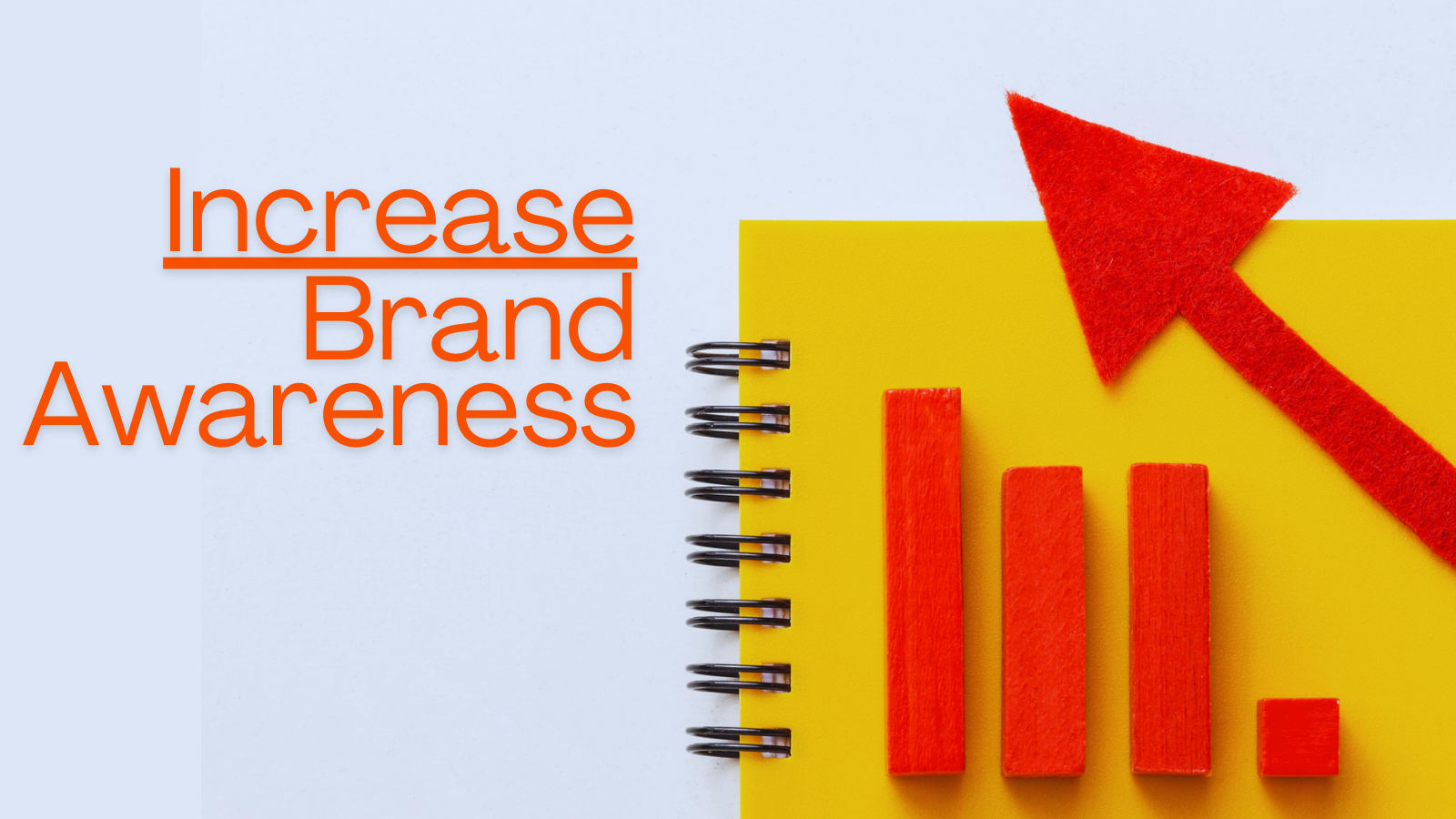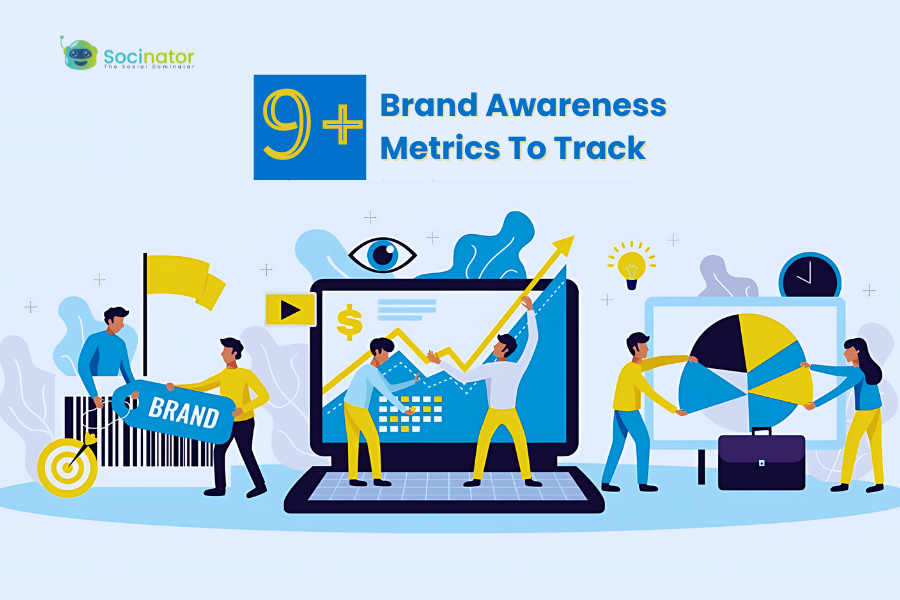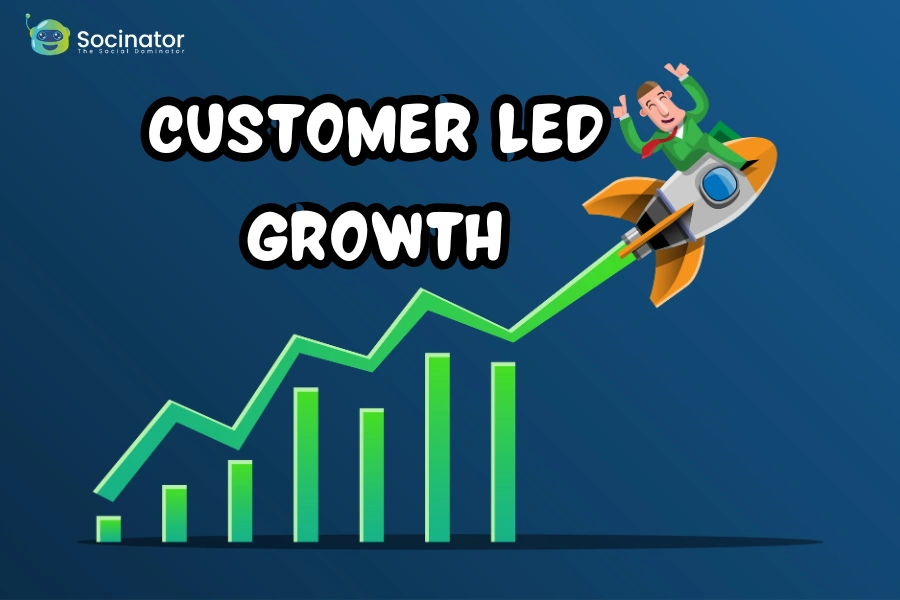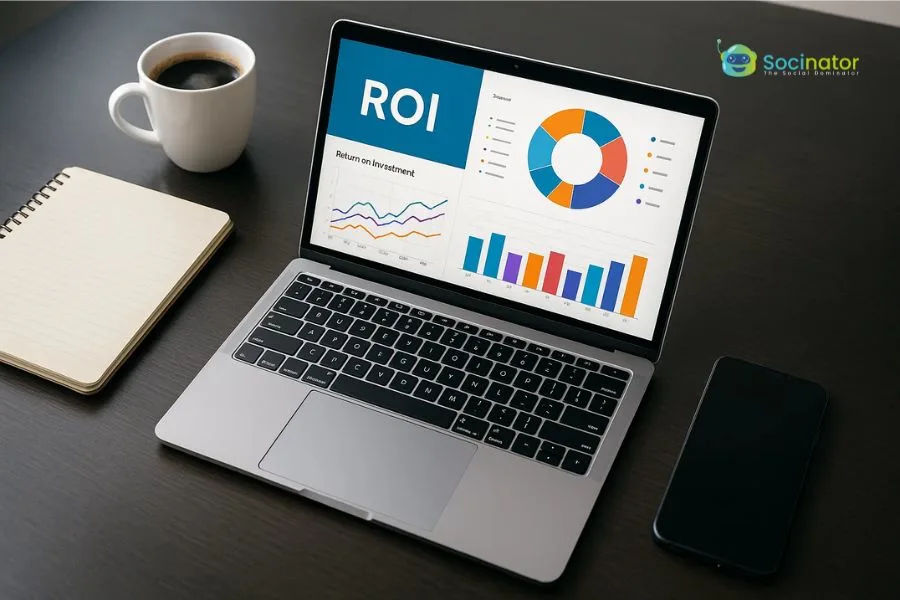A solid brand awareness is crucial for business success. But how can you determine if your brand is making a positive impact in the market? That’s where brand awareness metrics come in handy. These metrics help you understand how well your target audience recognizes and recalls your brand.
In this blog, we will explore the meaning of brand awareness metrics, their significance for brands, and essential metrics to track. We will also shed some insights on the methods for measuring brand awareness, strategies for crafting impactful awareness campaigns, and how focusing on social media engagement can help in increasing brand awareness.
Hit ‘Play’ Button & Tune Into The Blog!
What Are Brand Awareness Metrics?
At its core, brand awareness revolves around recognition and recall. Recognition refers to consumers’ ability to identify a brand when encountering visual or auditory cues like logos, slogans, or jingles. On the other hand, recall measures whether consumers can spontaneously remember a brand when considering a product category.
Brand awareness metrics are quantitative and qualitative measures used to evaluate how well a brand is recognized and recalled by its target audience. These metrics provide insights into the extent to which consumers are familiar with a brand and its products or services.
By analyzing these metrics, businesses can understand their brand’s visibility in the market, the effectiveness of their marketing efforts, and the strength of their brand equity.
Are you interested in improving your social media presence? Socinator could be your answer.
Get Started
Why Are They Important And How Can They Affect Brands?
 Brand awareness metrics serve as indicators for consumer perceptions and behaviors. A strong brand awareness can translate into enhanced customer loyalty, increased sales, and a competitive advantage.
Brand awareness metrics serve as indicators for consumer perceptions and behaviors. A strong brand awareness can translate into enhanced customer loyalty, increased sales, and a competitive advantage.
On the contrary, low brand awareness may hinder growth and limit market reach. By leveraging brand awareness metrics, brands can strategically position themselves in the minds of consumers, fostering engagement and nurturing lasting relationships.
Evaluate Marketing Efforts
Brand awareness metrics are essential for evaluating marketing efforts. For example, by monitoring brand recall metrics, which measure how readily customers remember your brand when prompted, businesses can effectively gauge the impact of their advertising campaigns.
Similarly, metrics like brand recognition, which assesses how well customers recognize your brand logo or name, provide insight into the reach of your marketing initiatives.
These insights are invaluable for marketers. They can pinpoint which campaigns are resonating with the target audience and which might need tweaking.
For instance, if brand recall is low despite heavy advertising spending, it might indicate a need for clearer messaging or more memorable branding elements.
On the other hand, high brand recognition coupled with positive brand associations can indicate successful brand positioning and messaging strategies.
Gauge Customer Trust And Loyalty
Consistent customer preference for your brand over others indicates trust and loyalty. Loyal customers not only purchase your products but also become brand advocates. They recommend your brand, leave positive reviews, and remain loyal even when competitors offer new alternatives.
Tracking spikes in social media engagements, such as likes, comments, shares, and mentions, reveals how customers perceive and interact with your brand. Positive customer interactions and repeat purchases signal strong customer trust and loyalty.
Competitive Positioning
Knowing how familiar your target audience is with your brand compared to others gives you a clear picture of your competitive position. Measuring brand awareness metrics helps you determine if you are the go-to choice or if you need to improve your standing.
This understanding goes beyond bragging rights. It reveals market gaps and opportunities. If your brand awareness is high in one demographic but low in another, you’ve identified a potential growth area. Conversely, if a competitor dominates a segment, you may need to rethink your strategy.
Strategic Partnerships and Alliances
A recognizable and reputable brand attracts the right partners. The more aware people are of your brand, the more appealing you become to potential allies. Whether it’s co-branding, sponsorships, or collaborative projects, a well-known brand is highly attractive.
Such strategic alliances are possible if you have a good understanding of your brand’s market awareness and reputation.
Guiding Product Development
Customer insights gained from the measurement of brand awareness metrics can inform product development and innovation. Understanding what customers know and think about your brand can help you develop products and services that meet their needs and preferences.
High brand awareness can also support the launch of new products or services under the same brand umbrella, leveraging the existing brand strength for successful introductions.
How To Measure Brand Awareness? (9+ Essential Metrics)
 Precisely measuring brand awareness can be challenging for many brands. However, you can track the following key brand awareness metrics that can provide a clear picture of your brand’s health and impact.
Precisely measuring brand awareness can be challenging for many brands. However, you can track the following key brand awareness metrics that can provide a clear picture of your brand’s health and impact.
Customer Sentiment
Customer sentiment reflects the emotional tone behind customer opinions and attitudes toward your brand. It reveals whether people are happy, frustrated, or indifferent about your business.
Analyzing reviews, social media comments, and feedback surveys can pinpoint what excites customers and what needs improvement. Gather and analyze customer sentiment across millions of online conversations, alerting you to spikes in brand mentions.
Monitoring sentiment trends helps you address emerging issues promptly and gauge the impact of your actions, ensuring a positive narrative around your brand.
Branded Search Volume
Branded search volume indicates how often people search for your brand name specifically, reflecting brand recall and recognition. High branded search volume signifies a strong brand impression and recognition.
Various tools can help you build queries with branded keywords to track relevant conversations about your brand and products. This information helps in conversations, control narratives, and boosts your brand’s presence in the market.
Customer Surveys
Direct insights into audience knowledge and brand perception are obtained through customer surveys. Surveys should be designed to assess brand awareness metrics, including brand recall and brand recognition.
The Customer Feedback Report aggregates customer satisfaction ratings from social media feedback surveys. This provides visibility into strengths and weaknesses based on individual responses and trends.
Earned Media
Earned media includes unpaid coverage of your brand in news articles, reviews, blog posts, and social media shoutouts. It amplifies your reach and credibility, reflecting public confidence in your brand.
Monitoring earned media mentions and sentiment shows how well-known and respected your brand is. Take the help of tools to help track these mentions, keeping you informed about your social presence and the nature of public conversations about your brand.
Share of Voice (SoV)
Share of Voice measures your brand’s presence in industry conversations. It shows how much of the market conversation you dominate, indicating the influence and authority of your brand.
Track and analyze your brand’s presence across social media, providing insights into metrics like positive sentiment, engagement, and unique authors. This data helps you refine strategies to boost your share of the conversation within your industry.
Google Trends Data
 Google Trends data shows how often people search for your brand over time. It helps identify trends, such as seasonal spikes in interest or changes in search volume over months.
Google Trends data shows how often people search for your brand over time. It helps identify trends, such as seasonal spikes in interest or changes in search volume over months.
Comparing your brand’s search interest with competitors gives a clear picture of your market standing. Use this data to capitalize on peak interest periods with targeted marketing campaigns.
Referral Traffic and Backlinks
Referral traffic and backlinks measure how often people visit your website through external links. High referral traffic from reputable sources enhances your website’s visibility and boosts your brand’s credibility.
It indicates that other sites value and talk about your brand, especially if referrals come from industry influencers or thought leaders. This metric highlights your brand’s authority and influence in the market.
Search Traffic
Search traffic reflects how often people find your website through search engines, showing active interest in your brand or the solutions you provide. It indicates that your marketing efforts, especially in SEO and content marketing, effectively enhance your brand’s visibility in search engine results.
Use this metric to measure market penetration and identify opportunities for improving visibility and awareness.
Conversions
One of the brand awareness metrics is conversions. Conversions track when interest transforms into action, such as a visitor becoming a buyer or a follower becoming a customer. High brand awareness often correlates with higher conversion rates.
Tools like Google Analytics provide detailed insights into each conversion event, allowing you to measure your brand’s impact. These insights help you track trends, identify successful strategies, and address areas needing improvement.
Social Media Engagement
How users interact with your content through likes, comments, shares, and saves is a good indicator of social media engagement. High engagement indicates that your content is captivating and relevant to your audience.
Maintaining good social media engagement requires a consistent presence and timely interaction with your audience. However, continuous engagement can be challenging, as many people rarely have the time to be online consistently.
To overcome this, you can use social media automation tools like Socinator. These tools offer options to schedule posts in advance, ensuring updates get published when your audience is most active.
Additionally, they provide automated response features, such as following, unfollowing, and replying to comments and direct messages, to help you maintain an active and engaged social media presence.
Socinator: Social Media Automation & Marketing Tool
 Socinator is a social media automation tool designed to help businesses and individuals efficiently manage and grow their social media presence. It supports multiple social media platforms, allowing users to automate various tasks such as posting content, engaging with followers, and analyzing performance. Socinator aims to save time and effort while maximizing the effectiveness of social media marketing strategies.
Socinator is a social media automation tool designed to help businesses and individuals efficiently manage and grow their social media presence. It supports multiple social media platforms, allowing users to automate various tasks such as posting content, engaging with followers, and analyzing performance. Socinator aims to save time and effort while maximizing the effectiveness of social media marketing strategies.
Key Features of Socinator
- Multi-Platform Support
- Supports popular social media platforms including Facebook, Instagram, Twitter, LinkedIn, Pinterest, Reddit, Tumblr, and YouTube.
- Allows users to manage all accounts from a single dashboard, streamlining social media management.
- Automated Posting
- Schedule and automate posts across different social media platforms.
- Customize posting schedules to maintain consistent activity and engagement.
- Auto-Liking and Auto-Commenting
- Automatically like and comment on posts from followers or target users.
- Increase engagement and visibility by interacting with potential customers and influencers.
- Auto-Follow and Auto-Unfollow
- Automatically follow users based on specific criteria such as hashtags, interests, or competitor followers.
- Auto-unfollow users who do not follow back, keeping your follower list relevant and engaged.
- Auto-Direct Messaging
- Send automated direct messages to new followers or target users.
- Use direct messages for promotions, customer service, or building relationships.
- Analytics and Reporting
- Track the performance of your social media activities with detailed analytics and reports.
- Measure key social media metrics such as follower growth, engagement rates, and post-performance to refine your strategy.
Socinator can act as your Pinterest, Facebook, Linkedin, or Instagram automation tool. With its wide array of features and functionalities, Socinator can help you to boost your social media engagement.
Read More
Social Media Metrics: Everything You Need To Know
How To Create Buzz For Your Business With Social Marketing?
5 Remarkable Marketing Campaigns for Your Brand
How To Increase Brand Awareness?
 To increase brand awareness, you should focus on creating an adequate campaign.
To increase brand awareness, you should focus on creating an adequate campaign.
Formulating an effective brand awareness campaign requires a strategic approach tailored to the target audience, market dynamics, and business objectives. Here are key steps to consider:
Define Clear Objectives
Establishing clear objectives is essential for a successful marketing campaign. Begin by identifying exact goals such as increasing brand recognition, reaching a new audience, or promoting specific products and services.
Defining these objectives provides direction and ensures that every aspect of your campaign aligns with your overall business strategy. This clarity aids in planning, execution, and measuring success.
Precise, measurable goals allow you to track progress effectively and demonstrate the impact of your marketing efforts.
Know Your Audience
Conducting in-depth market research is essential for understanding your target demographics. By delving into their preferences, behaviors, and media consumption habits, you can customize your messaging and choose the most effective channels to reach them.
Craft Compelling Messaging
Develop a unique value proposition that communicates the benefits of your products or services. Your messaging should be compelling and resonate with your target audience, setting you apart from competitors.
Focus on what makes your brand unique and why customers should choose you over others. Ensure your messaging is consistent across all channels to build a strong, cohesive brand image.
Utilize Multi-Channel Approach
Maximize your reach and engagement by using a variety of channels. This includes social media, content marketing, influencer partnerships, email marketing, and traditional advertising.
Each channel has its strengths, and using a combination allows you to connect with your audience at different touchpoints. A multi-channel strategy ensures that your message reaches a wider audience and reinforces your brand across multiple platforms.
Measure and Iterate
Continuously monitor and analyze brand awareness metrics throughout your campaign using tools like Google Analytics, social media insights, and customer feedback. Socinator can also help measure engagement across various social media platforms.
Use this data to evaluate campaign performance, identify strengths and weaknesses, and optimize future efforts. By iterating based on real-time insights, you can enhance the effectiveness of your campaigns and achieve your brand awareness goals efficiently.
Conclusion
Establishing and maintaining robust brand awareness is essential for sustained growth and success in a competitive marketplace. By comprehensively understanding and leveraging brand awareness metrics, businesses can gain invaluable insights into consumer perceptions, drive engagement, and forge long-lasting connections with their target audience. Through strategic brand awareness campaigns and diligent measurement of their impact, brands can position themselves for long-term success in today’s dynamic landscape.
By incorporating smart brand awareness strategies, businesses can unlock new avenues for growth and solidify their positions as industry leaders. Additionally, using social media automation tools like Socinator to enhance social media outreach can further amplify their efforts and engage with a broader audience.






